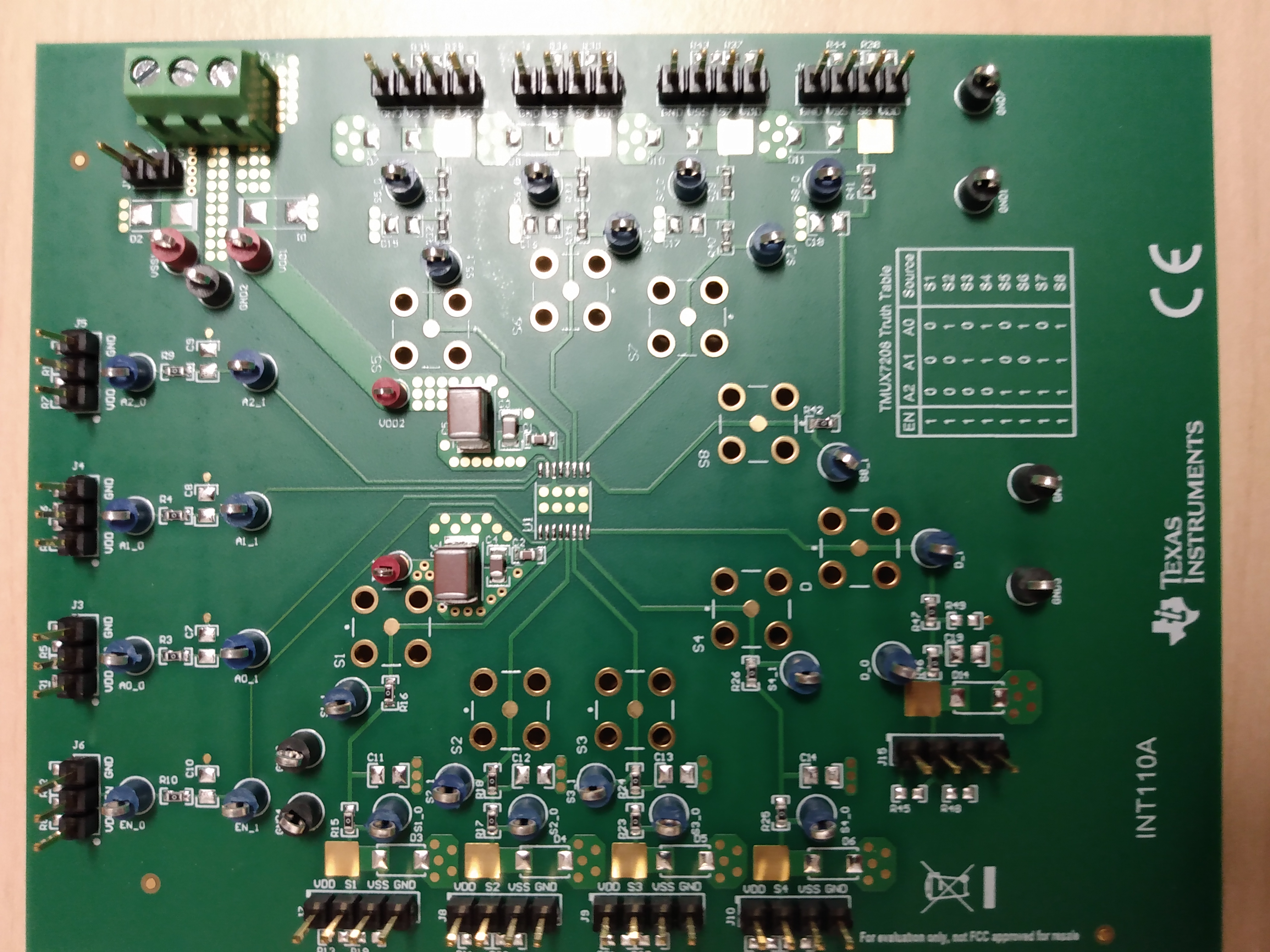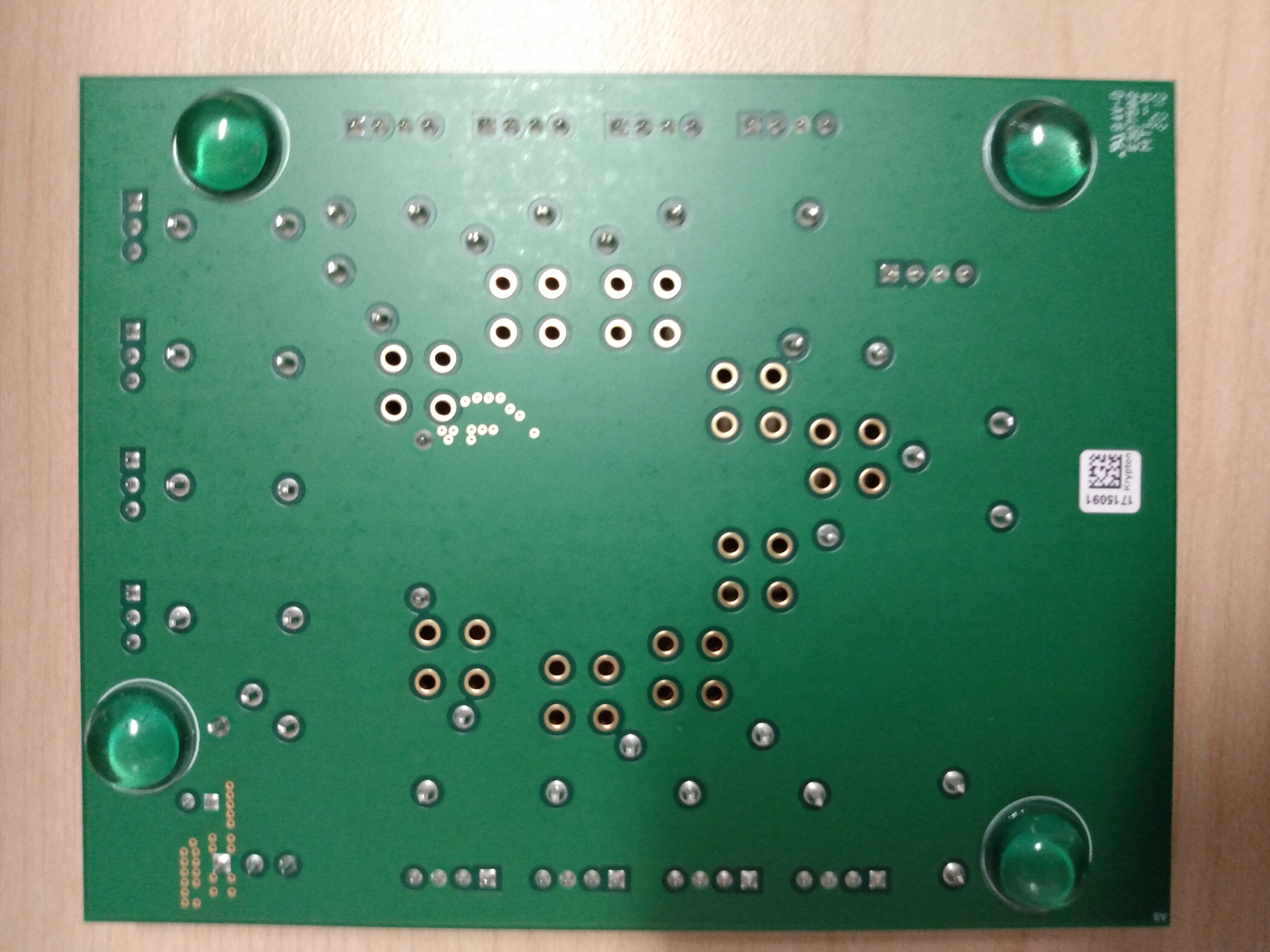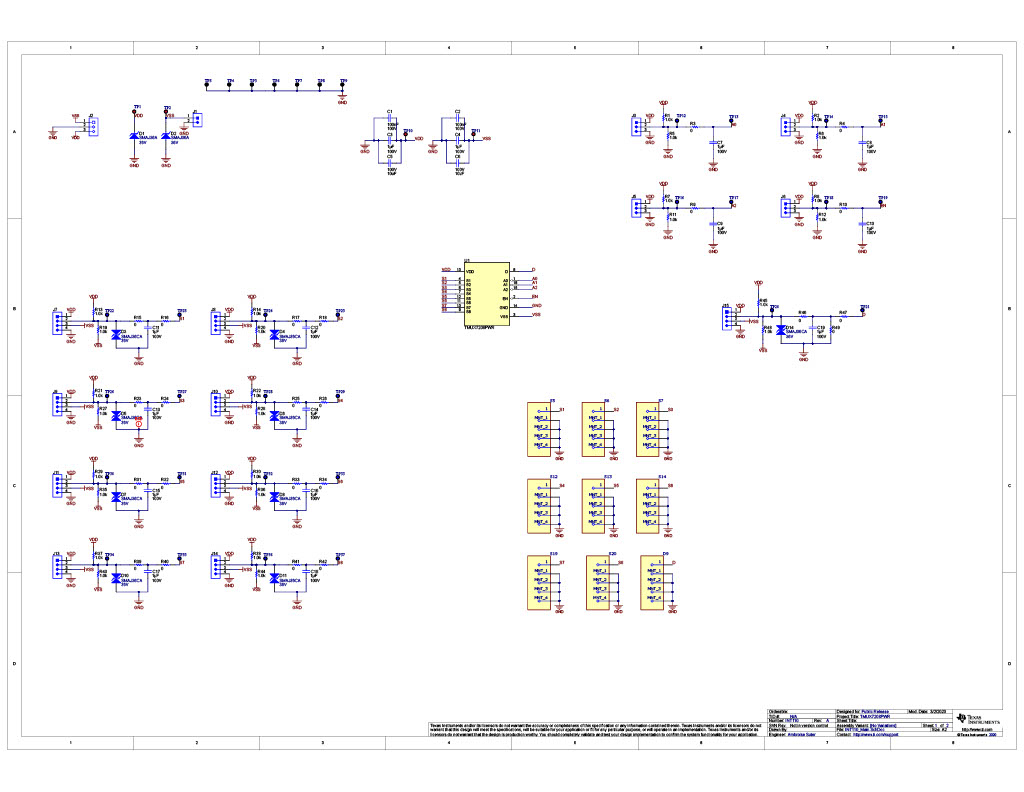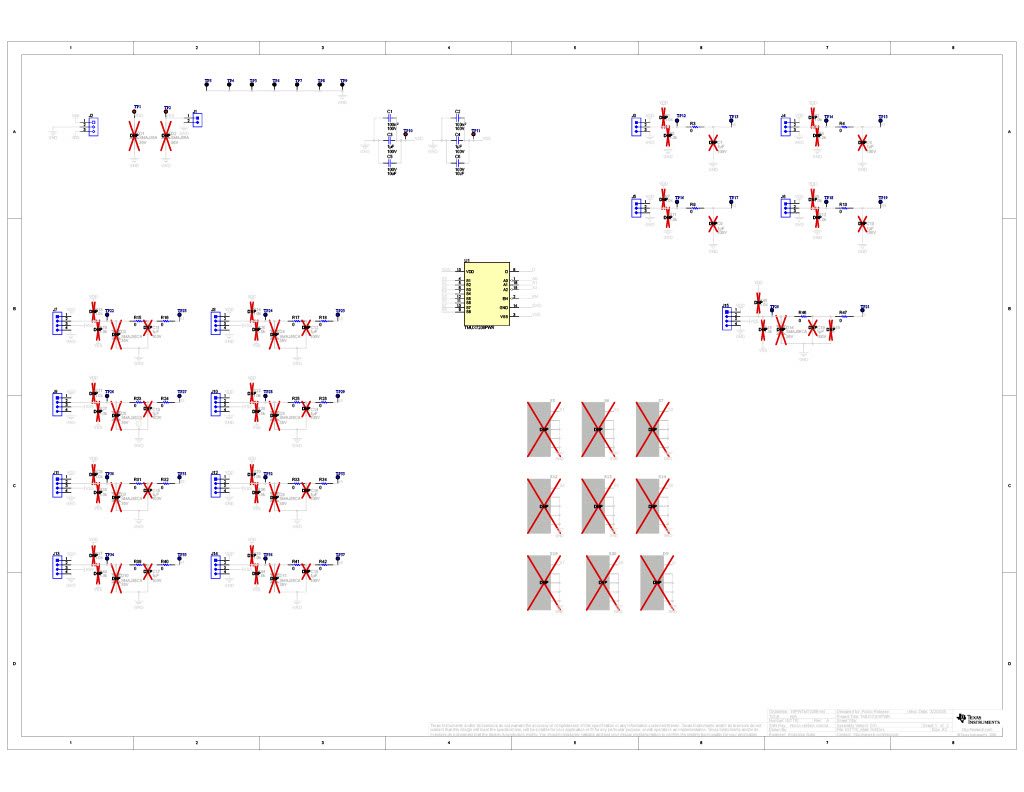-
TMUX7208EVM Evaluation Module
TMUX7208EVM Evaluation Module
Abstract
This user's guide describes the characteristics, operation, and use of the TMUX7208EVM evaluation module (EVM). A complete schematic diagram, printed-circuit board layouts, and bill of materials are included in this document.
Trademarks
All trademarks are the property of their respective owners.
1 Introduction
The TMUX7208EVM supports evaluation of the TMUX7208 device in the 16-pin TSSOP (PW) package. TMUX7208 is a complementary metal-oxide semiconductor (CMOS) switch with latch-up immunity in a 8:1 single channel configuration. The device supports dual supplies (±4.5 V to ±22 V), a single supply (4.5 V to 44 V), or asymmetric supplies (such as VDD = 12 V, VSS = –5 V). The TMUX7208 supports bidirectional analog and digital signals on the source (Sx) and drain (D) pins ranging from VSS to VDD. All logic control inputs support logic levels from 1.8 V to VDD, ensuring both TTL and CMOS logic compatibility when operating in the valid supply voltage range. The Fail-Safe Logic circuitry applies voltages on the control pins before the supply pin, which protects the device from potential damage.
2 Information About Cautions and Warnings

3 Features of this EVM
The EVM has the following features:
- Quick prototyping and testing setup for the 16-pin TMUX7208 device in the TSSOP (PW) package.
- TMUX7208 control logic truth table listed on board.
- No specific TMUX7208 is supplied or soldered to the evaluation module. Allows flexibility to choose the desired IC for evaluation.
- Support for both single supply and dual supply operation.
- Six power supply decoupling capacitors (2 × 0.1 μF, 2 × 1 μF, and 2 × 10 μF).
- Jumpers to nine signal lanes, VDD and VSS power rails, and control signals.
- Nine pads are available for placement of SMA connectors.
- Pads are available for pull-up or pull-down resistors on control signal pathways.
- Pads are available for surge protection diodes.
- 0805 capacitor pads are available on all signal pathways referenced to ground.
4 EVM Images
 Figure 4-1 TMUX7208EVM Topside View
Figure 4-1 TMUX7208EVM Topside View Figure 4-2 TMUX7208EVM Bottom View
Figure 4-2 TMUX7208EVM Bottom View5 EVM Setup
The following instructions are for setting up the EVM:
- The control inputs and signal
lines may be loaded by soldering components to signal path pads as needed.
describes which load pads correspond to what pin on the DUT. SMA connectors can
be soldered to corresponding pads accordingly.Table 5-1 Component Pad to TMUX7208 Pin Matrix
Pin # 0805 Capacitor Pad ID Protection Diode Pad Protection Diode PN# 0603 Pull-up Pad 0603 Pull-Down Pad Pad Locations 4 C11 D3 SMAJ36CA R13 R19 Top Layer 5 C12 D4 SMAJ36CA R14 R20 Top Layer 6 C13 D5 SMAJ36CA R21 R27 Top Layer 7 C14 D6 SMAJ36CA R22 R28 Top Layer 8 C19 D14 SMAJ36CA R45 R48 Top Layer 9 C18 D11 SMAJ36CA R38 R44 Top Layer 10 C17 D10 SMAJ36CA R37 R43 Top Layer 11 C16 D8 SMAJ36CA R30 R36 Top Layer 12 C15 D7 SMAJ36CA R29 R35 Top Layer - The board is powered by attaching ±5 V to ±22 V dual power supply or 5 V to 44 V single power supply to the screw terminal J2, with VDD, VSS, and GND oriented as specified in Table 6-1.
- Jumpers should be placed according to desired functionality. Figure 5-1 displays a generic four-pin jumper, with the indicating white corner to designate position 1.
 Figure 5-1 Generic Jumper and Header Position
1 Designator
Figure 5-1 Generic Jumper and Header Position
1 DesignatorTable 5-2 is the truth table for the TMUX7208, for reference to configure the corresponding control jumpers. Additional signal path jumpers may be configured as shown in Table 6-1.
| EN J6 |
A2 J5 |
A1 J4 |
A0 J3 |
Selected Source Connected to Drain (D) Pin |
|---|---|---|---|---|
| 0 | X(1) | X | X | All sources are off (HI-Z) |
| 1 | 0 | 0 | 0 | S1 |
| 1 | 0 | 0 | 1 | S2 |
| 1 | 0 | 1 | 0 | S3 |
| 1 | 0 | 1 | 1 | S4 |
| 1 | 1 | 0 | 0 | S5 |
| 1 | 1 | 0 | 1 | S6 |
| 1 | 1 | 1 | 0 | S7 |
| 1 | 1 | 1 | 1 | S8 |
6 EVM Connectors and Test Points
6.1 Connectors
| Jumper ID | Header Pos. 1 | Header Pos. 2 | Header Pos. 3 | Header Pos. 4 | Header Pos. 5 | Board Function | Fitted (Y/N) |
|---|---|---|---|---|---|---|---|
| J1 | GND | VSS | N/A | N/A | N/A | Power | Y |
| J2 | VSS | GND | VDD | N/A | N/A | Power | Y |
| J3 | VDD | A0 | GND | N/A | N/A | Control | Y |
| J4 | VDD | A1 | GND | N/A | N/A | Control | Y |
| J5 | VDD | A2 | GND | N/A | N/A | Control | Y |
| J6 | VDD | EN | GND | N/A | N/A | Control | Y |
| J7 | VDD | S1 | VSS | GND | N/A | I/O | Y |
| J8 | VDD | S2 | VSS | GND | N/A | I/O | Y |
| J9 | VDD | S3 | VSS | GND | N/A | I/O | Y |
| J10 | VDD | S4 | VSS | GND | N/A | I/O | Y |
| J11 | VDD | S5 | VSS | GND | N/A | I/O | Y |
| J12 | VDD | S6 | VSS | GND | N/A | I/O | Y |
| J13 | VDD | S7 | VSS | GND | N/A | I/O | Y |
| J14 | VDD | S8 | VSS | GND | N/A | I/O | Y |
| J15 | VDD | D | VSS | GND | N/A | I/O | Y |
| S1 | I/O | GND | GND | GND | GND | I/O SMA | N |
| S2 | I/O | GND | GND | GND | GND | I/O SMA | N |
| S3 | I/O | GND | GND | GND | GND | I/O SMA | N |
| S4 | I/O | GND | GND | GND | GND | I/O SMA | N |
| S5 | I/O | GND | GND | GND | GND | I/O SMA | N |
| S6 | I/O | GND | GND | GND | GND | I/O SMA | N |
| S7 | I/O | GND | GND | GND | GND | I/O SMA | N |
| S8 | I/O | GND | GND | GND | GND | I/O SMA | N |
| D | I/O | GND | GND | GND | GND | I/O SMA | N |
6.2 Test Points
| Signal | Test Point ID |
|---|---|
| VDD | TP1 and TP10 |
| GND | TP3, TP4, TP5, TP6, TP7, TP8, and TP9 |
| VSS | TP2 and TP11 |
| D | TP20 and TP21 |
| S1 | TP22 and TP23 |
| S2 | TP24 and TP25 |
| S3 | TP26 and TP27 |
| S4 | TP28 and TP29 |
| S5 | TP30 and TP31 |
| S6 | TP32 and TP33 |
| S7 | TP34 and TP35 |
| S8 | TP36 and TP37 |
| A0 | TP12 and TP13 |
| A1 | TP14 and TP15 |
| A2 | TP16 and TP17 |
| EN | TP18 and TP19 |
7 PCB Layouts
Figure 7-1 and Figure 7-2 show the EVM PCB layout images.
 Figure 7-1 Top View Illustration of the
TMUX7208EVM Layout.
Figure 7-1 Top View Illustration of the
TMUX7208EVM Layout.  Figure 7-2 Bottom View Illustration of
the TMUX7208EVM Layout.
Figure 7-2 Bottom View Illustration of
the TMUX7208EVM Layout. 8 Schematics
Schemetic views fo the TMUX7208EVM. Figure 8-1 shows the editor view, which includes all connections and parts that are DNI. Figure 8-2 shows DNI view, removing DNI parts which are not included on the evaluation model out-of-the-box.
 Figure 8-1 Schematic of the TMUX7208EVM (Editor View)
Figure 8-1 Schematic of the TMUX7208EVM (Editor View) Figure 8-2 Schematic of the TMUX7208EVM (DNI View)
Figure 8-2 Schematic of the TMUX7208EVM (DNI View)9 Bill of Materials
Table 9-1 details the EVM bill of materials.
| Designator | Component | Manufactuer | Description | Quantity |
|---|---|---|---|---|
| C1, C2 | CKG45NX7S2A106M500JJ | TDK | CAP, CERM, 10 µF, 100 V, ± 20%, X7S, AEC-Q200 Grade 1, 1812 | 2 |
| C4, C5 | C1608X7S2A104K080AB | TDK | CAP, CERM, 0.1 µF, 100 V, ± 10%, X7S, 0603 | 2 |
| C6, C7 | C2012X7S2A105K125AB | TDK | CAP, CERM, 1 µF, 100 V, ± 10%, X7S, 0805 | 2 |
| H1, H2, H3, H4 | SJ-5303 (CLEAR) | Bumper Specialties, Inc. | Bumpon, Hemisphere, 0.44 X 0.20, Clear | 4 |
| J1 | 691214110003 | Wurth Electronics | Terminal Block, 3.5 mm, 3×1, Tin, TH | 1 |
| J2 | PEC02SAAN | Sullins Connector Solutions | Header, 100 mil, 2×1, Tin, TH | 1 |
| J3, J8, J5, J9, J10 | PEC03SAAN | Sullins Connector Solutions | Header, 100 mil, 3×1, Tin, TH | 5 |
| R3, R4, R5, R6, R9, R10, R13, R14 | RMCF0603ZT0R00 | Stackpole Electronics Inc | RES, 0, 1%, 0.1 W, AEC-Q200 Grade 0, 0603 | 8 |
| SH-J? | SPC02SYAN | Sullins Connector Solutions | Shunt, 100 mil, Flash Gold, Black | 7 |
| TP1, TP3, TP4, TP6, TP8, TP9, TP10, TP11, TP14, TP15, TP17, TP18 | 5000 | Keystone | Test Point, Miniature, Red, TH | 12 |
| J2 | 691214110003 | Würth Elektronik | Terminal Block, 3.5 mm, 3×1, Tin, TH | 1 |
| J7, J8, J9, J10, J11, J12, J13, J14, J15 | PEC04SAAN | Sullins Connector Solutions | Header, 100 mil, 4×1, Tin, TH | 9 |
| A0.0, A0.1, A1.0, A1.1, A2.0, A2.1, D0, D1, EN0, EN1, S1.0, S1.1, S2.0, S2.1, S3.0, S3.1, S4.0, S4.1, S5.0, S5.1, S6.0, S6.1, S7.0, S7.1, S8.0, S8.1 | 5122 | Keystone Electronics | Test Point, Compact, Blue, TH | 26 |
| GND1, GND2, GND3, GND4, GND5, GND6, GND7 | 5006 | Keystone Electronics | Test Point, Compact, Black, TH | 7 |
| VDD1, VSS1 | 5005 | Keystone Electronics | Test Point, Compact, Red, TH | 2 |
| VDD2 | 5000 | Keystone Electronics | Test Point, Miniature, Red, TH | 1 |
| VSS2 | 5000 | Keystone Electronics | Test Point, Miniature, Red, TH | 1 |
| J3, J4, J5, J6 | PEC03SAAN | Sullins Connector Solutions | Header, 100 mil, 3×1, Tin, TH | 4 |
| J1 | PEC02SAAN | Sullins Connector Solutions | Header, 100 mil, 2×1, Tin, TH | 1 |
| C5, C6 | CKG45NX7S2A106M500JJ | TDK Corporation | CAP, CERM, 10 µF, 100 V, ± 20%, X7S, AEC-Q200 Grade 1, 1812 | 2 |
| H9, H10, H11, H12 | SJ-5303 (CLEAR) | 3M | Bumpon, Hemisphere, 0.44 X 0.20, Clear | 4 |
| C3, C4 | C2012X7S2A105K125AB | TDK Corporation | CAP, CERM, 1 µF, 100 V, ± 10%, X7S, 0805 | 2 |
| C1, C2 | C1608X7S2A104K080AB | TDK Corporation | CAP, CERM, 0.1 µF, 100 V, ± 10%, X7S, 0603 | 2 |
| R3, R4, R9, R10, R15, R16, R17, R18, R23, R24, R25, R26, R31, R32, R33, R34, R39, R40, R41, R42, R46, R47, R49 | RMCF0603ZT0R00 | Stackpole Electronics Inc. | RES, 0, 1%, 0.1 W, AEC-Q200 Grade 0, 0603 | 23 |
10 Related Documentation
- Texas Instruments, Electrostatic Discharge (ESD) application report
11 Revision History
Changes from Revision * (December 2020) to Revision A (December 2020)
- Added link to Electrostatic Discharge (ESD) application report in the Information About Cautions and Warnings sectionGo